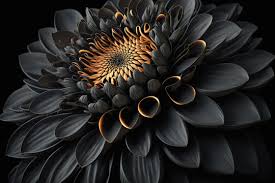Black Dahlias cultivation requires attention to detail and proper care.
Discover the meaning of the Black Dahlia flower, its history, and the skill involved in growing this alluring beauty. The name “Black Dahlia” is sometimes linked to a terrible incident that occurred in 1947 and resulted in Elizabeth Short’s untimely death, but the flower itself is a work of art in nature that represents strength, mystery, and elegance. We examine the complex tapestry of the Black Dahlia in this in-depth guide, including details on its description, history, variants, and symbolism in addition to vital planting and maintenance advice.
Description of the Flower
The Black Dahlia, a perennial tuberous plant belonging to the Asteraceae family, graces gardens with its continuous blooming from June to October. Whether adorning beds, borders, or planters, its impressive diversity in shapes and colors, including dwarf varieties suitable for pots, makes it a summer favorite. With its long stems and sizable petals, the Black Dahlia stands out as a striking choice for summer bouquets.
Origin of the Flower
Originating primarily from Mexico, Colombia, and Central America, the Black Dahlia, initially known as “Cocoxochitl” by the Aztec people, held a practical purpose in feeding animals despite its bitter taste. Introduced to France in 1802 by botanist Dr. Thibaus, the Swedish botanist Andreas Dahl lent his name to this prolific flower. The interbreeding of species expanded its range, resulting in an array of vibrant dahlias, showcasing the plant’s genetic diversity.
Varieties
Dive into the kaleidoscope of dahlias with thousands of hybrid varieties. From cactus dahlias to frill dahlias, the Black Dahlia offers an extensive range of colors, shapes, and sizes. Some resemble daisies, pompoms, or blooming peonies, while others boast vibrant hues of yellow, red, salmon, orange, and more. Embrace the versatility of Black Dahlia varieties, from towering giants to petite, multicolored blooms.
Symbolism
In the Victorian era, the language of flowers conveyed sentiments that couldn’t be openly expressed. The Black Dahlia symbolizes commitment, an eternal bond, elegance, and dignity. A bearer of intimate feelings, it represents loyalty, happiness, change, and, paradoxically, betrayal. As a symbol of lush beauty and power, the Black Dahlia’s multifaceted symbolism adds depth to its allure.
Black Dahlia Cultivation and Care Tips
Cultivating Black Dahlias is a rewarding endeavor. Plant them in sun-exposed areas with well-watered, clay soil between late April and early May. Proper spacing, staking for support, and regular watering are crucial. Fertilize with compost or liquid fertilizer for flowering plants, ensuring vibrant blooms. Prune wilted flowers, consider removing secondary stems and first buds for a more abundant display.
Follow these essential tips for Black Dahlia Cultivation and vibrant blossoming of this captivating flower:
- Sun Exposure: Choose a well-lit location for planting your Black Dahlias, ensuring they receive ample sunlight throughout the day. These flowers thrive in full sun, contributing to robust growth and abundant blooms.
- Soil Preparation: Black Dahlias prefer well-draining soil with a slightly acidic to neutral pH. Incorporate organic matter, such as compost or well-decomposed manure, to enhance soil fertility and structure.
- Planting Depth: Plant Black Dahlia tubers in late April to early May at a depth ranging from 3 to 10 centimeters, depending on the size of the bulb. Ensure proper spacing, with larger varieties requiring approximately one meter apart and dwarf Dahlias about 50 centimeters apart.
- Support Structures: Given the potential height of some varieties, stake the plants to provide support against gusts of wind. This helps maintain the upright growth of the stems, preventing breakage or damage.
- Watering Routine: Establish a regular watering routine, especially during hot and dry weather. Daily watering or the use of drip irrigation helps keep the soil consistently moist, promoting healthy growth. Avoid wetting the foliage, as damp leaves can encourage the development of diseases.
- Fertilization: Nourish your Black Dahlias with a balanced fertilizer, compost, or well-decomposed manure, particularly if the soil is light. For potted Dahlias, liquid fertilizer formulated for flowering plants can be applied to promote vigorous blooming.
- Pruning and Deadheading: To stimulate continuous flowering, promptly remove wilted flowers as they appear. Consider pruning secondary stems and the first flower buds in spring to encourage more abundant blooms, albeit in lesser numbers.
By adhering to these cultivation practices, you can ensure that your Black Dahlias thrive, gracing your garden with their stunning array of colors and shapes throughout the summer months.
The Black Dahlia: A Unique Addition to Gardens
While black flowers may evoke notions of darkness and mourning, the Black Dahlia defies these stereotypes. Amid the cheerful and lively ambiance expected in gardens, the unique color of black dahlias adds a touch of intrigue. Although often perceived as more red than black, they challenge conventional expectations, making a bold statement in any garden landscape.
Diseases and Pests
Like any plant, the Black Dahlia is susceptible to diseases such as verticillium wilt, botrytis, and anthrax. Vigilance against slugs, aphids, and red spiders is crucial to maintaining the plant’s health. Despite potential challenges, the astonishing diversity and resilience of the Black Dahlia make it a resilient and visually stunning addition to any garden.
Conclusion : Black Dahlia Cultivation
In conclusion, the Black Dahlia transcends its association with a tragic event, emerging as a symbol of beauty, resilience, and horticultural prowess. From its diverse varieties to profound symbolism, this guide serves as an in-depth exploration of the Black Dahlia flower. Cultivate this captivating bloom to infuse your garden with elegance, mystery, and the timeless allure of the enigmatic Black Dahlia.

